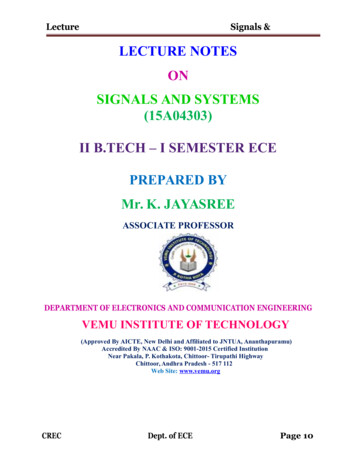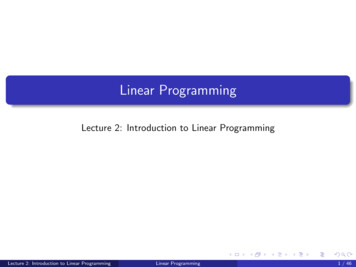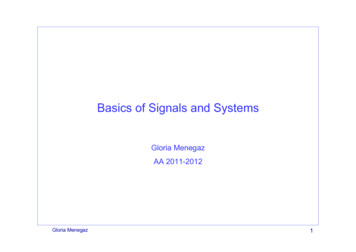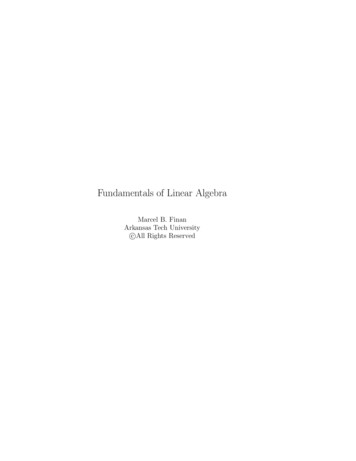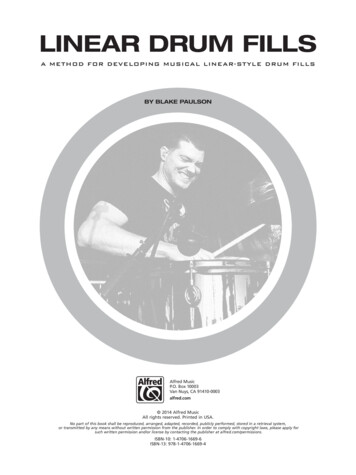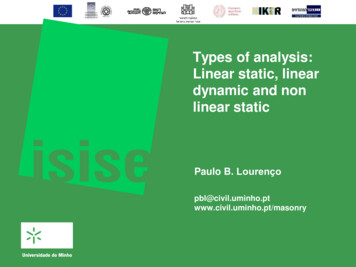
Transcription
EE2 Signals and Linear SystemsPier Luigi DragottiElectrical & Electronic Engineering DepartmentImperial College LondonURL: http://www.commsp.ee.ic.ac.uk/ pld/Teaching/E-mail: p.dragotti@imperial.ac.ukPLD Autumn 2016Signals and Linear SystemsLecture 1
Aims and Objectives‣“The concepts of signals and systems arise in a variety offields and the techniques associated with these notions play acentral role in many areas of science and technology such as,for example, communications, aeronautics, bio-engineering,energy, circuit design, ect. Although the physical nature ofthe signals and systems involved in these various disciplinesare different, they all have basic features in common. Theaim of the course is to provide the fundamental and universaltools for the analysis of signals, and for the analysis anddesign of basic systems and this independently of the domainof application.”PLD Autumn 2016Signals and Linear SystemsLecture 1 Slide 2
Aims and ObjectivesBy the end of the course, you will have understood:-Basic signal analysis (mostly continuous-time)-Basic system analysis (also mostly continuous systems)-Time-domain system analysis (including convolution)-Laplace and Fourier Transform-System Analysis in Laplace and Fourier Domains-Filter Design-Sampling Theorem and signal reconstructions-Basics on z-transformPLD Autumn 2016Signals and Linear SystemsLecture 1 Slide 3
About the course Lectures - 15 hours over 8-9 weeks Problem Classes – 7-8 hours over 8-9 weeks Assessment – 100% examination in June Handouts in the form of pdf slides also available athttp://www.commsp.ee.ic.ac.uk/ pld/Teaching/ and on BlackBoard Discussion board available on Blackboard Text Book:- Recommended Text Book: B.P. Lathi, “Linear Systems andSignals”, 2nd Ed., Oxford University Press- Also useful: A.V. Oppenheim & A.S. Willsky “Signals and Systems”,Prentice HallPLD Autumn 2016Signals and Linear SystemsLecture 1 Slide 4
Lecture 1Basics about Signals(Lathi 1.1-1.5)Pier Luigi DragottiElectrical & Electronic Engineering DepartmentImperial College LondonURL: http://www.commsp.ee.ic.ac.uk/ pld/Teaching/E-mail: p.dragotti@imperial.ac.ukPLD Autumn 2016Signals and Linear SystemsLecture 1
Outline‣‣‣‣Examples of SignalsSome useful Signal OperationsClassification of SignalsSome useful Signals-PLD Autumn 2016Unit Step FunctionUnit Impulse FunctionThe Exponential FunctionSignals and Linear SystemsLecture 1 Slide 6
Examples of Signals (1)‣Electroencephalogram (EEG) SignalPLD Autumn 2016Signals and Linear SystemsLecture 1 Slide 7
Examples of Signals (2)‣Stock Market Data as a discrete-time signalPLD Autumn 2016Signals and Linear SystemsLecture 1 Slide 8
Examples of Signals (3)‣Magnetic Resonance Image (MRI) as a 2-dimensional signalPLD Autumn 2016Signals and Linear SystemsLecture 1 Slide 9
Useful Signal Operations: Time ShiftingPLD Autumn 2016Signals and Linear SystemsLecture 1 Slide 10
Useful Signal Operations: Time Scalingφ(t/2) x(t)φ(2t) x(t)PLD Autumn 2016Signals and Linear SystemsLecture 1 Slide 11
Signals Classification‣Signals may be classified into:-PLD Autumn 2016Energy and power signalsDiscrete-time and continuous-time signalsAnalogue and digital signalsDeterministic and probabilistic signalsPeriodic and aperiodic signalsEven and odd signalsSignals and Linear SystemsLecture 1 Slide 12
Signals Classification: Energy vs PowerSize of a signal x(t)PLD Autumn 2016Signals and Linear SystemsLecture 1 Slide 13
Signals Classification: Energy vs Power (2)PLD Autumn 2016Signals and Linear SystemsLecture 1 Slide 14
Signals Classification: Energy vs Power (3)PLD Autumn 2016Signals and Linear SystemsLecture 1 Slide 15
Signals Classification: Continuous-time vsDiscrete-timePLD Autumn 2016Signals and Linear SystemsLecture 1 Slide 16
Signals Classification: Analogue vs DigitalPLD Autumn 2016Signals and Linear SystemsLecture 1 Slide 17
Signals Classification: Deterministic vsRandomPLD Autumn 2016Signals and Linear SystemsLecture 1 Slide 18
Signals Classification: Periodic vs AperiodicPLD Autumn 2016Signals and Linear SystemsLecture 1 Slide 19
Signals Classification: Even vs Oddfe(t) fe(-t)fo(t) -fo(-t)PLD Autumn 2016Signals and Linear SystemsLecture 1 Slide 20
Signals Classification: Even vs Odd (2)PLD Autumn 2016Signals and Linear SystemsLecture 1 Slide 21
Useful Signals: Unit Step Function u(t)PLD Autumn 2016Signals and Linear SystemsLecture 1 Slide 22
Useful Signals: Pulse SignalA pulse signal can be represented using two step functions. E.g:PLD Autumn 2016Signals and Linear SystemsLecture 1 Slide 23
Useful Signals: Unit Impulse Function δ(t)PLD Autumn 2016Signals and Linear SystemsLecture 1 Slide 24
Sampling Property of the Unit Impulse FunctionIt follows that:If we want to sample φ(t) and t T, we multiply by δ(t-T):PLD Autumn 2016Signals and Linear SystemsLecture 1 Slide 25
The Exponential Function est (1)‣The exponential function is very important in signals & systems.‣The parameter s is a complex variable given by:s σ jωPLD Autumn 2016Signals and Linear SystemsLecture 1 Slide 26
The Exponential Function est (2)‣The exponential function est can be used to model a large class ofsignals.‣Here are a few examples:PLD Autumn 2016Signals and Linear SystemsLecture 1 Slide 27
The Exponential Function est (3)PLD Autumn 2016Signals and Linear SystemsLecture 1 Slide 28
The Complex Frequency Plane s σ jωPLD Autumn 2016Signals and Linear SystemsLecture 1 Slide 29
Discrete-Time Exponential γn‣A continuous-time exponential est can be expressed in alternate formaswithste γγ ets‣Similarly we have for discrete-time exponentials λne γn‣The form γn is preferred for discrete-time exponentials‣When Re{λ} 0, then γ 1 and the exponential decays‣When Re{λ} 0, then γ 1 and the exponential grows‣When λ is purely imaginary then γ 1 and the exponential is constant-amplitudeand oscillatesL3.3-3 p254PLD Autumn 2016 Signals and Linear SystemsLecture 1 Slide 30
Discrete-Time Exponential γn (cont’d)L3.3-3 p255PLD Autumn 2016Signals and Linear SystemsLecture 1 Slide 31
PLD Autumn 2016 Signals and Linear Systems Lecture 1 Slide 3 Aims and Objectives By the end of the course, you will have understood: - Basic signal analysis (mostly continuous-time) - Basic system analysis (also mostly continuous systems) - Time-domain system analysis (including convolution) - Laplace and Fourier Transform - System Analysis in Laplace and Fourier Domains
